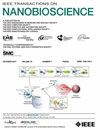A Thermal Study of Terahertz Induced Protein Interactions
IF 4.4
4区 生物学
Q1 BIOCHEMICAL RESEARCH METHODS
引用次数: 0
Abstract
Proteins can be regarded as thermal nanosensors in an intra-body network. Upon being stimulated by Terahertz (THz) frequencies that match their vibrational modes, protein molecules experience resonant absorption and dissipate their energy as heat, undergoing a thermal process. This paper aims to analyze the effect of THz signaling on the protein heat dissipation mechanism. We therefore deploy a mathematical framework based on the heat diffusion model to characterize how proteins absorb THz-electromagnetic (EM) energy from the stimulating EM fields and subsequently release this energy as heat to their immediate surroundings. We also conduct a parametric study to explain the impact of the signal power, pulse duration, and inter-particle distance on the protein thermal analysis. In addition, we demonstrate the relationship between the change in temperature and the opening probability of thermally-gated ion channels. Our results indicate that a controlled temperature change can be achieved in an intra-body environment by exciting protein particles at their resonant frequencies. We further verify our results numerically using COMSOL Multiphysics® and introduce an experimental framework that assesses the effects of THz radiation on protein particles. We conclude that under controlled heating, protein molecules can serve as hotspots that impact thermally-gated ion channels. Through the presented work, we infer that the heating process can be engineered on different time and length scales by controlling the THz-EM signal input.太赫兹诱导蛋白质相互作用的热学研究
蛋白质可被视为体内网络中的热纳米传感器。当受到与其振动模式相匹配的太赫兹(THz)频率刺激时,蛋白质分子会发生共振吸收,并将能量以热量的形式耗散,从而经历一个热过程。本文旨在分析太赫兹信号对蛋白质散热机制的影响。因此,我们采用了一个基于热扩散模型的数学框架,来描述蛋白质如何从刺激电磁场中吸收太赫兹电磁(EM)能量,并随后将这些能量以热量的形式释放到其周围环境中。我们还进行了参数研究,以解释信号功率、脉冲持续时间和粒子间距离对蛋白质热分析的影响。此外,我们还证明了温度变化与热门控离子通道开启概率之间的关系。我们的研究结果表明,在体内环境中,通过激发蛋白质粒子的共振频率,可以实现可控的温度变化。我们使用 COMSOL Multiphysics® 进一步对结果进行了数值验证,并引入了一个实验框架来评估太赫兹辐射对蛋白质颗粒的影响。我们的结论是,在受控加热条件下,蛋白质分子可作为热点影响热门控离子通道。通过所介绍的工作,我们推断出可以通过控制太赫兹电磁信号输入,在不同的时间和长度尺度上设计加热过程。
本文章由计算机程序翻译,如有差异,请以英文原文为准。
求助全文
约1分钟内获得全文
求助全文
来源期刊

IEEE Transactions on NanoBioscience
工程技术-纳米科技
CiteScore
7.00
自引率
5.10%
发文量
197
审稿时长
>12 weeks
期刊介绍:
The IEEE Transactions on NanoBioscience reports on original, innovative and interdisciplinary work on all aspects of molecular systems, cellular systems, and tissues (including molecular electronics). Topics covered in the journal focus on a broad spectrum of aspects, both on foundations and on applications. Specifically, methods and techniques, experimental aspects, design and implementation, instrumentation and laboratory equipment, clinical aspects, hardware and software data acquisition and analysis and computer based modelling are covered (based on traditional or high performance computing - parallel computers or computer networks).
 求助内容:
求助内容: 应助结果提醒方式:
应助结果提醒方式:


